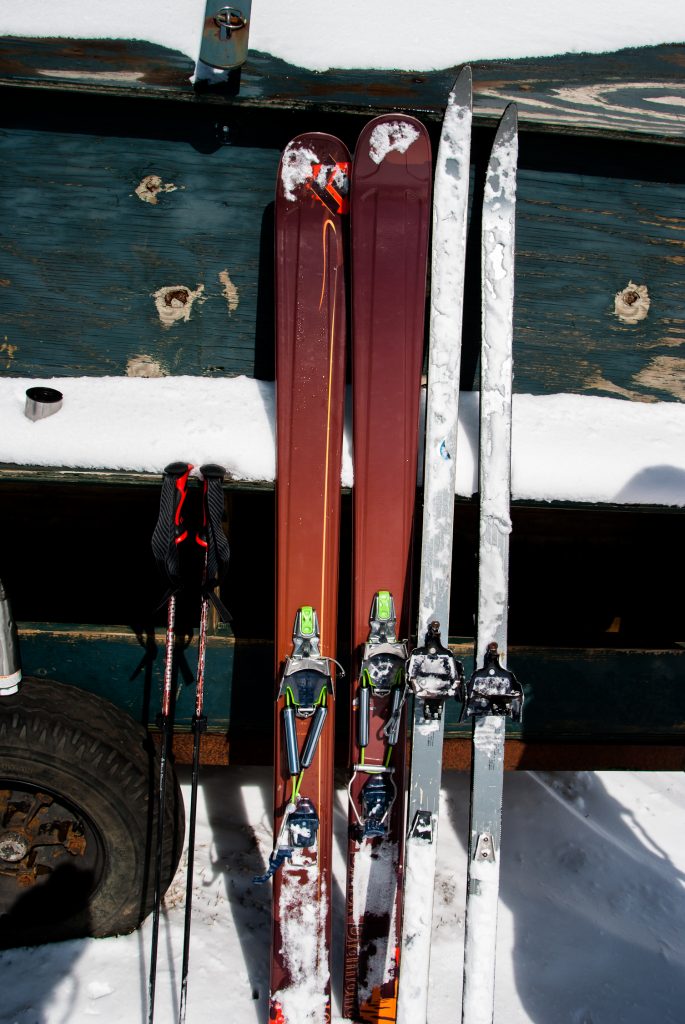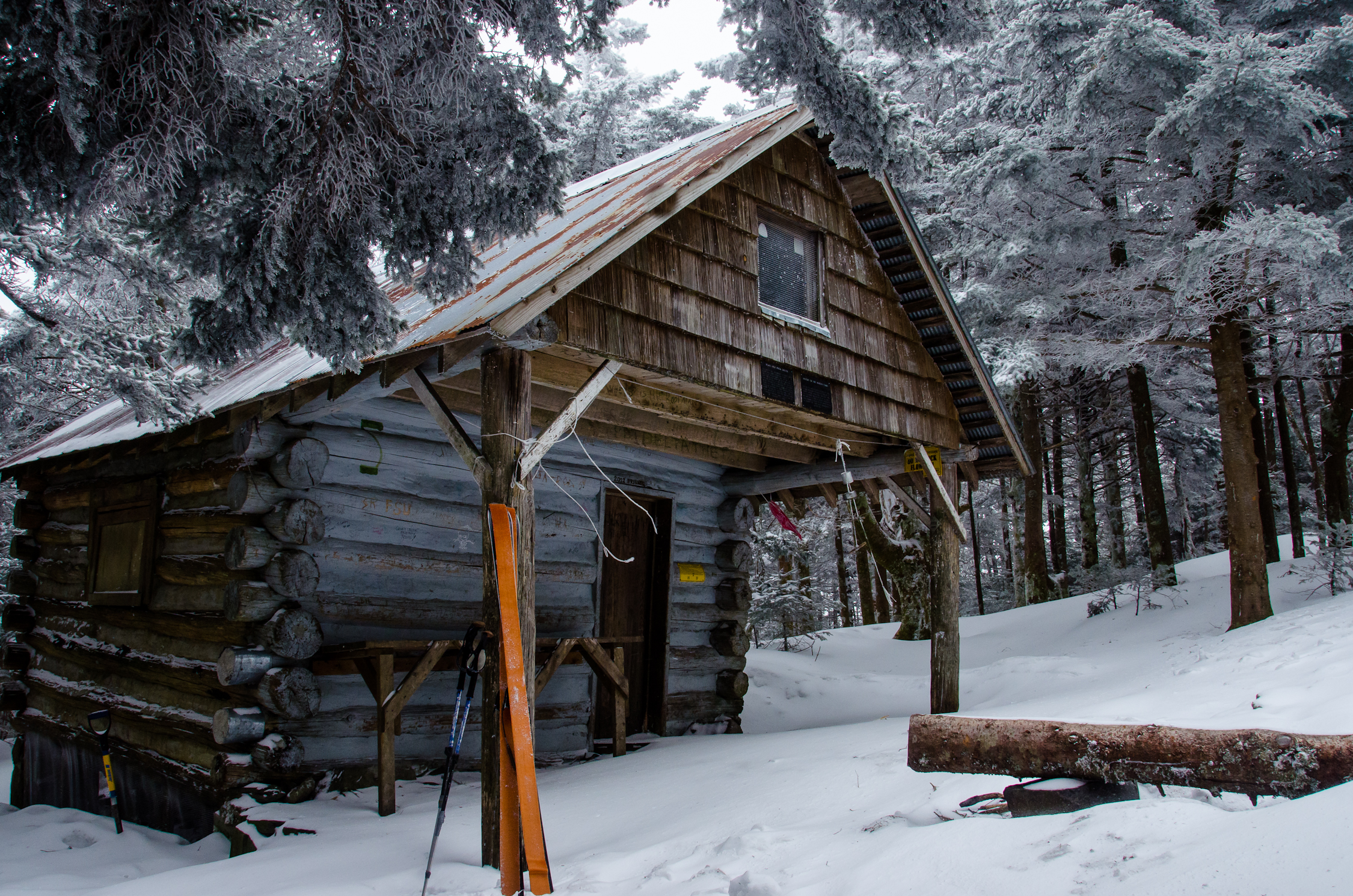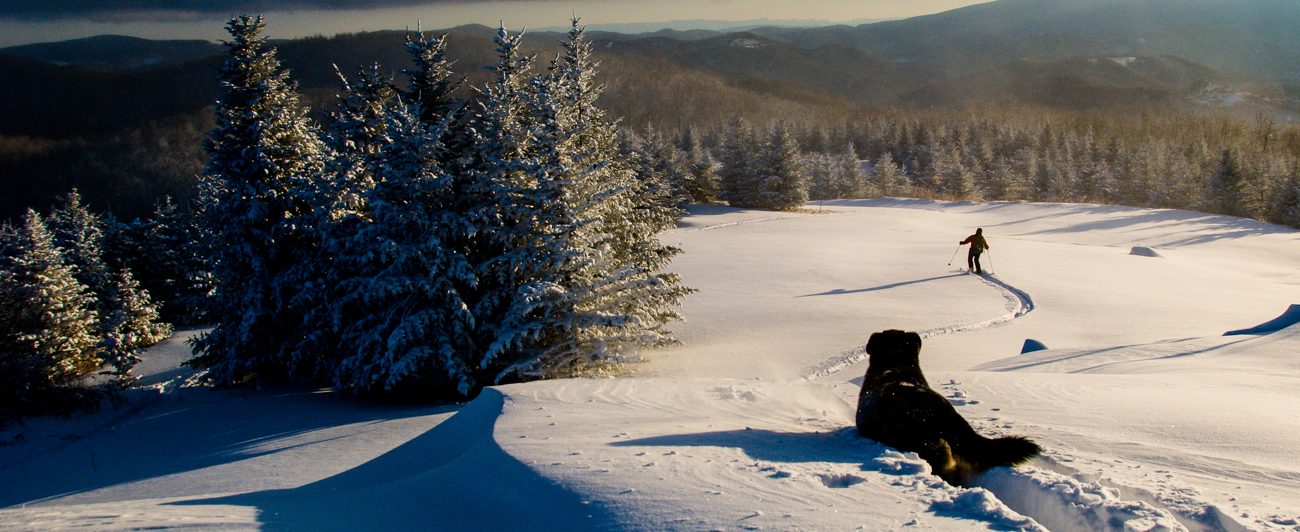Straight Line
Useless and Essential
North Carolina Optimism
ABOVE Rising over 6,000 feet, Roan Mountain is covered with a network of trails, including the Roan High Knob Shelter, which—during snowy winters—provides a taste of the backcountry hut experience for southerners.
The email came in August a few years ago, from a stranger. Snow is far from most people’s consciousness that time of year; in the Southeast US it might as well be a fairy tale. Which made the subject line in my inbox so surprising.
“Seeking first descents in the southern Appalachians,” it said. I immediately started to read.
His name was Robert Hoffman. “I’m moving to the area from New York and was researching if I was going to be able to ski down here, and your photos keep popping up,” the email said. We agreed to meet.
Robert had done his homework. As if he was planning an expedition, he had studied elevations, slope angles, climate history and weather patterns, and had identified a few key zones he thought would make for “all-time, classic ski descents.” And he had the skiing credentials to pull them off.
There was one problem, I told him. This is North Carolina. We can’t count on snow, let alone good snow. Yet his ideas were intriguing. Because, if you’ve been a skier in the Southeast for long, you know there is a secret alchemy that sometimes turns the rocky, tree-coated peaks white. It’s what keeps the state’s five remaining ski resorts and their die-hard cult following going.
And over the past few decades, it’s inspired what Robert was searching for: Backcountry skiing in North Carolina.
Running along the western edge of the state, the southern Appalachians have been a popular mountain vacation spot for over a century, and with peaks rising over 6,600 feet are the highest east of the Mississippi. While winters are often warm and wet, the impressive geography and 300-mile proximity to the ocean can create storms that pound the summits. Usually it’s a few inches, but other times it’s a few feet, nearly 10 feet on good years. It’s enough to eke out a 100-day season, if you don’t mind “variable conditions”—so variable that winter forecasts for the region weren’t even close to accurate until 1991, when a professor from Appalachia State University in Boone installed a series of weather stations.
Robert knows all this. He’s read Southern Snow, a book by Randy Johnson documenting the NC winters of the early 1980s, which were the coldest and snowiest on record. So much snow fell that it motivated two Outward Bound instructors to start a ski-touring operation on the tall, weather-battered Roan Mountain. “The High South Nordic Guides,” as they were called, introduced many southerners to the concept of human-powered skiing. Then multiple years of drought in the late ‘80s forced the operation to close. Ski touring in Dixie Land faded to near extinction.

ABOVE In 2009, North Carolina saw huge amounts of snow, turning Dixie Land into a ski touring paradise. Justin Studt enjoys the tail end of December’s third blizzard in the high country.
Two decades later, in December of 2009, a series of powerful blizzards raked the high summits with heavy snowfalls. Locals dusted off their tele boots and skins; others started bootpacking. Snow fell nearly every day that month, opening hike-to lines and zones most had only read about. Old timers made comparisons to the best days of the High South Nordic Guides.
It snowed the rest of that winter. The high country developed an actual snowpack, and it became common to run into other parties sliding around in the woods. The term “North Carolina backcountry” was even bandied about. It looked as if it might become official as a group of telemarkers—calling themselves the High Country Nordic Association—began publicly sharing condition reports, organizing trips and generally promoting backcountry skiing in the region. They sponsored a “Tele Fest” at Beech Mountain Resort that year, and the next season amassed a collection of loaner skis, touring boots and skins for people to try out the sport.
Even now, the movement has largely been limited to locals—not as a way to protect powder stashes, but because outsiders are confounded by the thought of making human-powered turns where it never snows. We know though. When it all lines up, it’s time to ski.
Robert is one of those outsiders, but his scientific approach has made him a believer. He’s seen the zones, and knows that the dream of “North Carolina backcountry” is more than a myth. After that initial email we began studying maps, making reconnaissance missions, and gathering together a team of fellow dreamers.
This past December, however, the temps averaged 60 degrees in the southern Appalachians. None of the ski hills opened. We ate Christmas dinner in shorts with the house windows open. The biking season was long.
But come January, the jet stream shifted. Forecasts were hesitantly optimistic, then apocalyptic. The first storm of the season was poised to bring feet of snow to the high country. Phone calls and emails flashed back and forth, “Who’s in?” Robert asked. “And what’s good?”
My thoughts were on another truth-turned-fairytale—Captain Ahab and Moby Dick. Yes, big snow will fill in these lines, but what will five feet of snow on top of no base actually look like? What will the winds do to the snowpack? Storybooks don’t always end happily, and I didn’t want this one to be our white whale.

ABOVE The Nordic Norm. Due to a few big snow years in the early 1980s, telemarking surged in popularity in North Carolina, even spawning a backcountry guide service. On the right, some of the last remaining skis in use from the now-defunct company, the High South Nordic Guides.
Driving north from Boone at 5 a.m., the roads were slow going. School was out for the day The plows had yet to make the rounds, and the refrain of “I hate snow” was being repeated over breakfast tables—a reminder that for most people here, snow is mainly a disruption of plans: “What do we do with the kids? How do I get to work?”
Unlike Captain Ahab, we had decided to settle for a tamer goal than the first descent we originally had in mind: Elk Knob State Park, mellower than the highest parts of the area, but still reaching to 5,520 feet. The mood was somber. Faced with the reality of the mission at hand, skiing seemed both a futile pursuit of the useless and absolutely essential. Either way, the wind snapped us out of any philosophizing. We cinched up our hoods against the -20 F wind chill, and headed up. Following old farm roads and stepping over the fences bordering open fields, the thin layer of white didn’t improve our mood.
At 5,000 feet, that suddenly changed. Snow plastered the trees and quickly deepened as we scrambled to the summit, looking over our snowy domain. Like the closet in a C.S. Lewis book, it seemed as if we’d found a portal from NC to someplace in the distant north or west—even if the view in the distance was almost entirely green.
We made lap after lap until we had fully tracked out the snowy microclimate, knowing these could be our only turns of the season. And while they weren’t all-time Appalachian first descents, it was a storybook ending for one hell of a Dixie Land fairytale.
